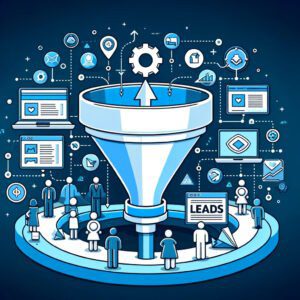Mastering the art of lead generation is crucial for website success.
This article delves into effective strategies that can transform your website into a lead-generating powerhouse.
From optimizing your landing pages to leveraging SEO and content marketing, we’ll guide you through actionable steps to attract and convert visitors into loyal customers.
Discover how to harness the full potential of your website and secure a competitive edge in your industry.

Understanding Lead Generation
Lead generation is the marketing process of stimulating and capturing interest in a product or service with the objective of developing a sales pipeline. It’s the first step in the customer acquisition process, which can be achieved by driving traffic to your website and converting that traffic into leads.
Importance of Lead Generation
Mastering lead generation is an essential aspect for business growth. It’s a cost-effective strategy for targeting potential customers, enhancing brand awareness, building relationships, and ultimately increasing your ROI.
A successful lead generation strategy provides a steady stream of qualified leads, ensuring a robust sales pipeline. Refining your lead generation strategies is an important aspect for maximizing the potential of lead.
You can have a more in-depth understanding on Lead Generation by reading our previous article.
Defining Your Audience
Identifying your Target Market
To generate leads effectively, you must know who your target audience is. This involves researching demographic data, psychographics, consumer behaviour, and buying habits. Understanding your target market is the foundation of any successful online marketing strategy.
Understanding your Audience’s Needs
Once you’ve identified your target market, it’s essential to understand their needs. What problems are they trying to solve? What are their pain points?
By understanding their needs, you can tailor your value proposition, content marketing, and overall marketing strategy to attract and convert these prospects.
Developing a Strong Value Proposition
Defining your Unique Selling Proposition
Your unique selling proposition (USP) is what sets you apart from the competition. It’s the reason why customers should choose your product or service over others.
By addressing a unique need or problem of your target audience, your USP should not only be compelling but also designed to attract and engage customers in a meaningful way.
This differentiation is crucial in capturing attention and fostering a connection, making it clear why your offering is the superior choice.
Creating a Compelling Value Proposition
A compelling value proposition is one that resonates with your target audience. It effectively communicates the unique benefits of your product or service, how it solves their problem, and why it’s better than other offerings in the market.
Designing an Attractive Website
Importance of Website Design in Lead Generation
Your website and landing pages are the hub of all your digital marketing efforts. A well-designed website can significantly increase your website traffic, attract potential customers, improve user experience, and ultimately generate more leads.
It’s your digital storefront, and it should be designed to attract, engage, and convert visitors.
If you need help to create or redesign your website, contact us.
Key Elements of an Effective Website
Creating an effective website involves more than just sleek design or compelling content; it’s about combining various elements that enhance user experience, improve functionality, and drive conversions. Here’s a checklist of key elements to ensure your website is effective and engaging:
Clear Value Proposition
- Concise Headline: Immediately communicates the value of your product or service.
- Unique Selling Points: Highlights what sets you apart from competitors.
User-Friendly Design
- Intuitive Navigation: Easy-to-use menu and navigation structure.
- Responsive Design: Optimized for desktop, tablet, and mobile devices.
- Consistent Layout: Uniform design elements and color scheme across all pages.
You can learn more about User-Friendly Design here.
High-Quality Content
- Engaging Copy: Well-written, informative, and tailored to your target audience.
- Visual Elements: High-quality images and videos that complement the text.
- Regular Updates: Fresh content to keep the website dynamic and interesting.
This step is often difficult, AI tools can help you to create engaging content.
Strong Call-to-Action (CTA)
- Visibility: Prominently placed CTAs that stand out.
- Clarity: Clear and concise messaging on what to do next.
- Variety: Different CTAs for varying levels of engagement.
Find some Strong Call to Action here.
SEO for Lead Generation
Importance of SEO
Search engine optimization (SEO) is the cornerstone of your successful online lead generation strategy, playing a pivotal role in how effectively you can attract and engage potential customers.
By optimizing your website content, structure, and on-page elements like meta tags and images for relevant keywords, you can significantly enhance your visibility on search engine results pages (SERPs).
This increased visibility isn’t just about drawing more traffic; it’s about attracting the right kind of traffic—users actively searching for the solutions that you offer.
Essentially, SEO bridges the gap between you and your target audience, facilitating a connection with individuals who are most likely to convert into leads and, ultimately, customers.
Through strategic SEO practices, you can achieve higher rankings and enhance your lead generation, which boosts your credibility and authority in your niche. Leading to higher engagement rates, improved user experience, and a substantial increase in qualified lead generation.
SEO Strategies for Lead Generation
Effective SEO strategies for lead generation include keyword optimization, creating quality backlinks, optimizing for mobile, and producing SEO-friendly content. SEO is an ongoing process that requires constant monitoring and optimization.
A little guide to your first steps in the SEO realm
AI-Powered Chatbot
AI-powered chatbots have emerged as a revolutionary tool for enhancing lead generation strategies.
These intelligent chatbots offer businesses an innovative way to engage with website visitors, providing immediate responses and personalized interactions at scale.

24/7 Availability and Instant Engagement
One of the most significant advantages of AI-powered chatbots is their ability to offer round-the-clock engagement on your website. Unlike human representatives, chatbots can interact with potential leads any time of day or night.
This constant availability ensures that no visitor leaves the website without an interaction, boosting the chances of converting casual browsers into leads.
Instant engagement through chatbots can answer visitors’ questions in real-time, keeping them engaged and interested in your offerings.
Reducing Bounce Rates
AI-powered chatbots can significantly reduce website bounce rates by engaging visitors immediately upon their arrival.
By offering assistance, answering questions, and guiding users through the website, chatbots can enhance user engagement and satisfaction.
Keeping visitors engaged longer on the site not only improves the chances of lead generation but also positively impacts SEO rankings, driving more organic traffic to the website.
Contact us to get started with your own Chatbot.
Multilingual Translation
The ability to communicate with a diverse international audience is not just an advantage—it’s essential.
For businesses looking to expand their reach, multilingual translation of their website is a pivotal strategy. It is a powerful tool for lead generation.
This process not only breaks down language barriers but also opens up new markets, enhances user experience, and reflects a brand’s global outlook.
Here’s a deeper dive into why multilingual translation is critical and how to effectively implement it.
Nowadays, with AI, it’s never been easier to translate content in any language.
The Importance of Multilingual Translation
- Broader Reach: Translating your website into multiple languages makes your content accessible to a wider audience. It’s a direct pathway to engaging potential customers in their native language, significantly expanding your market.
- Improved SEO: Multilingual websites rank higher in search engines for non-English queries. This increased visibility can drive more traffic to your site, leading to higher conversion rates.
- Enhanced User Experience: A website that speaks the user’s language is inherently more user-friendly. It shows respect for different cultures and can significantly improve customer satisfaction and loyalty.
- Competitive Edge: Offering multiple language options can set you apart from competitors. It demonstrates a commitment to inclusivity and global engagement, traits highly valued in the modern marketplace.
Implementing Effective Multilingual Translation
- Choose Your Languages Wisely: Research your target markets to identify which languages will most benefit your business. Consider factors like market size, potential growth, and the competitive landscape.
- Professional Translation Services: Relying on automatic translation tools can lead to inaccuracies. Invest in professional translation services to ensure high-quality, culturally sensitive translations.
- Localize Your Content: Translation is just the first step. Localizing content—adjusting it to fit cultural norms and expectations—can further enhance its relevance and appeal to international audiences.
- SEO Strategy for Each Language: Implement an SEO strategy tailored to each language. This includes optimizing for local keywords, meta descriptions, and leveraging hreflang tags to tell search engines about the multilingual versions of your page.
- Continuous Updates and Maintenance: As your website evolves, so should its translations. Regularly update and maintain the multilingual content to ensure accuracy and relevance.
- User-Friendly Language Selection: Make it easy for visitors to switch languages on your website. A visible language selection option improves the overall user experience.
Multilingual translation is more than just converting text from one language to another; it’s about creating connections with a global audience.
By effectively implementing a multilingual strategy, businesses can not only extend their reach but also build deeper relationships with customers worldwide.
As commerce continues to globalize, the ability to communicate across languages will remain a key driver of success.
Content Marketing Strategy
Role of Content in Lead Generation
Content plays a pivotal role in lead generation. It’s a way to provide value to your audience, build trust, establish authority, and attract potential leads. It’s also a critical component of SEO, social media marketing, and email marketing. Create content that appeals to your potential and current customers.
Tips for Creating Engaging Content
Creating engaging content that addresses the needs, involves understanding your target audience. By providing valuable information and making it easily digestible.
Whether it’s blog posts, videos, infographics, whitepaper, or ebooks, your content should be compelling, unique, and relevant.
Newsletters
Newsletters are a potent tool in the digital marketer’s arsenal, particularly when it comes to lead generation on websites. By integrating newsletters effectively into your digital strategy, you can not only drive more traffic to your website but also nurture leads through the sales funnel.
Here’s a comprehensive look at how newsletters can significantly impact lead generation on your website.

Building a Subscriber Base
This involves creating opportunities on your website for visitors to sign up for your newsletter.
By offering a subscription form as a part of your lead magnet strategy—such as access to exclusive content, discounts, or free trials—you can convert casual visitors into subscribers.
These subscribers represent a direct line to your target audience, allowing for personalized engagement.
Enhancing Engagement Through Personalization
Newsletters allow for personalized communication with potential leads. By segmenting your subscriber list based on user behavior, preferences, or demographics, you can tailor your newsletters to meet the specific interests of different audience segments.
Personalized content has a higher chance of resonating with your audience. Thereby increasing engagement rates, driving traffic back to your website, and moving leads further down the sales funnel.
Establishing Authority and Trust
Regular newsletters that provide value to your subscribers help establish your brand as an authority in your field. By sharing insightful articles, industry news, and expert advice, you can build trust with your audience.
This trust is fundamental in converting leads into customers, as consumers are more likely to purchase from brands they view as knowledgeable and reliable.
Encouraging Repeat Website Visits
Each newsletter you send is an opportunity to direct traffic to your website. Whether it’s to read a blog post, check out a new product, or take advantage of a special offer, strategically placed links within your newsletter can significantly increase website visits.
These repeated interactions with your website increase the likelihood of conversion, as they keep your brand top-of-mind and encourage deeper engagement with your content.
Accelerating the Conversion Process
Newsletters can play a crucial role in accelerating the conversion process. By nurturing your leads with regular updates and valuable content, you reduce the length of the sales cycle.
Special promotions, limited-time offers, and exclusive content shared through newsletters can create a sense of urgency, encouraging subscribers to take action—be it making a purchase, signing up for a webinar, or downloading a whitepaper.
Measuring and Optimizing Performance
One of the key advantages of newsletters is the ability to measure their impact through analytics. Metrics such as open rates, click-through rates, and conversion rates provide insight into how effectively your newsletters are contributing to your lead scoring.
This data allows for continuous optimization of your strategy, helping you to refine your content, segment your audience more effectively, and enhance your overall lead generation efforts.
Incorporating newsletters into your website’s lead generation strategy offers a multifaceted approach to attracting, engaging, and converting high-quality leads.
By building a subscriber base, personalizing communication, establishing authority, encouraging website visits, accelerating conversions.
And continuously optimizing based on performance metrics, newsletters can significantly enhance the effectiveness of your lead generation efforts.
To maximize their impact, ensure that your newsletters are consistently providing value and aligned with the broader goals of your digital marketing strategy.
Making sure that your emails end up in the right folder is just as important as the strategy behind the newsletter. Get to know more about how your emails mind end up in the Spam Folder.
Conversion Optimization Strategies
Importance of Conversion Optimization
Conversion optimization is the process of increasing the percentage of website visitors who achieve a desired action. It’s vital for maximizing the effectiveness of your lead generation efforts.
Techniques for Improving Conversion Rate
Improving conversion rates involves various strategies like A/B testing, improving website design, optimizing landing pages, and enhancing CTAs. It’s about making it as easy as possible for visitors to become leads.
Email Marketing for Lead Generation
Importance of Email Marketing
Email marketing is a highly effective lead generation strategy. It allows you to directly communicate with your audience, nurture leads, and promote your offerings.
Email Marketing Strategies
Successful email marketing strategies involve segmenting your audience, personalizing emails, providing value, and optimizing for mobile. It’s about delivering the right message to the right person at the right time.
It also involves following the right regulations to avoid unnecessary fines through the RGPD. Make sure to give the choice to your subscribers to unsubscribe at any moment.
Mastering the art of lead generation is no small task. It requires a deep understanding of your target audience, a compelling value proposition, a well-designed website, effective SEO, engaging content, optimized conversion strategies, strategic social media use, and effective email marketing.
With these strategies, you can maximize your lead generation efforts and drive your business growth.
Interested in one or several of the solutions presented? Iterates experts can help you integrate them into your daily activities and boost your lead generation now.
